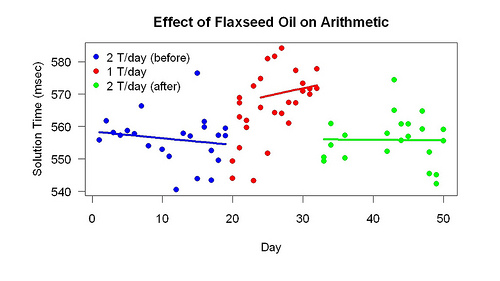At a Mr. Lee’s restaurant (a Chinese chain), I started chatting with a girl sitting near me. I told her I was a psychology professor. “You know what people are thinking,” she said. I lamely said, no, I study what foods make the brain work best.
“I don’t know the English word for it,” she said. She drew a walnut. Good for your brain, her parents had told her. I was astonished. When I got to China, my arithmetic scores mysteriously improved. I had expected them to get worse, if anything. I tried to duplicate my American diet in Beijing but it is hard to duplicate the flaxseed oil. (Chinese flaxseed oil is worthless. I can bring it from America but not easily, and it’s impossible to keep it cold the whole way.) I had tested various explanations of the improvement but none held up.
I was starting to believe the reason for the improvement was walnuts. I have two servings/day of yogurt, each time with walnuts. I ate a lot of yogurt with walnuts in Berkeley, too; this was not a dramatic change. But maybe I eat more walnuts in China, and maybe the walnuts have more omega-3. Maybe the walnuts are fresher. In Berkeley I put ground flaxseed in my yogurt (in addition to walnuts), without obvious improvement. Walnuts are lower in omega-3 than flaxseeds.
A Chinese friend of mine had told me the same thing — that her parents had said that walnuts are good for the brain. This is a common Chinese belief, mingled with the curious idea that they are good for the brain because they look like a brain. The Wikipedia entry for walnut, which includes its use in Chinese medicine, says nothing about improving brain function. This long article about the benefits of walnuts doesn’t connect them directly with better brain function. It does say they are considered “brain food” because of high omega-3 content and links to a page that says 1/4 cup of walnuts (25 g) has 2.3 g of omega-3. I am now consuming 2 tablespoons/day of flaxseed oil, which contains 14 g of omega-3. I have sometimes consumed 3 or 4 tablespoons/day (with 21 or 28 g omega-3). You can see why 2 g doesn’t impress me, especially when added to 14 g. I thought I was getting the optimal amount of omega-3 from flaxseed oil. Adding a small amount to the optimal amount shouldn’t have a noticeable effect. This article says walnuts are brain food because of their lecithin content. Lecithin is used to make acetylcholine, a neurotransmitter.
Miraculously I can gather better evidence by myself, in a month, than all the evidence I’ve found. I simply vary how much walnuts I eat and see what happens to my arithmetic score. The experiment is worth doing because of the common Chinese belief and my puzzlingly good scores. Maybe walnuts help a brain that is already getting plenty of omega-3. Maybe not.
